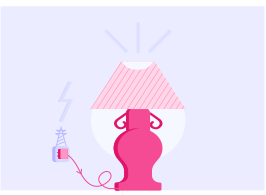YOU ARE LEARNING:
Stores of Energy

Stores of Energy
Some forms of energy can be stored by objects. This stored energy can later be released and transferred into a different form of energy.
There are 9 types of energy, but only some of these can be stored in order to be converted into different forms of energy. Out of the 9 types, which ones do you think can be stored?

You can select multiple answers
So we talk about types of energy and stores of energy.
7 out of the 9 types of energy can be stored, namely gravitational potential energy, nuclear energy, kinetic energy, elastic potential energy, heat energy, chemical energy and electrical energy.
Now, there are 7 main stores of energy. Which ones do you think they are?

You can select multiple answers
To recap!
There are 9 types of energy
Heat, sound, electromagnetic (light), kinetic, chemical, electrical, gravitational potential, elastic potential and nuclear energy.
Only 7 of these types of energy can be stored
Namely gravitational potential, nuclear, kinetic, elastic potential, heat, chemical and electrical energy.
There are 7 main stores of energy
Kinetic, elastic potential, gravitational potential, electrical, magnetic, nuclear and internal energy (which includes heat and chemical energy).
Kinetic energy
What is another way of describing kinetic energy?

All things in motion have kinetic energy, whether they're very large like planets, or very small like atoms.
The amount of kinetic energy an object has depends on the mass and speed of the object.
Internal energy
All objects have internal energy. What forms of energy does internal energy include?

You can select multiple answers
So internal energy usually refers to an object's internal heat or chemical energy
Thermal energy is caused by the movement of particles within an object. Chemical energy is stored in the bonds between particles of the object which can be released in chemical reactions.
Elastic potential energy (EPE)
Elastic potential energy (EPE) is energy stored in a stretched or compressed object. Which of these are examples of this?

You can select multiple answers
Elastic potential energy is stored in stretched or squashed materials.
Some objects, like springs and rubber bands, are able to deform their shape reversibly. For example, when a rubber band is stretched it can regain its original shape again.
Gravitational potential energy (GPE)
All objects have a gravitational field strength, but what is the largest object near us that has the biggest force of gravity?

Later lesson will look at this in more detail.
For now, just know that when an object moves away from the Earth (is elevated to a height), it gains GPE.
What do you think the amount of gravitational potential energy an object gains depends on?

You can select multiple answers
What form of energy do you think GPE gets converted into?

The more GPE an object gains as its raised higher, the faster it will fall back down to Earth.
So GPE is converted into kinetic energy.
Electric potential energy
Electricity is the form of energy that an electrical circuit contains. Certain objects can store this electric energy. These objects must be...

Some objects, like electrons, carry electrical charge and create electric fields.
Charged objects can exert forces on each other. When these particles move, that is an electric current. Later lessons will look at this in more detail.
Magnetic potential energy
This is not a trick question! What objects do you think store magnetic potential energy?

Similar to electrically charged objects, some objects can be magnetised and create magnetic fields.
Magnetic objects can exert forces on other magnetised objects, or on magnetic materials. More on this in later lessons.
Nuclear energy
Where do you think nuclear energy is stored?

The energy stored in the nucleus of an atom is called nuclear energy
Nuclear power plants then use this energy to generate electricity.
